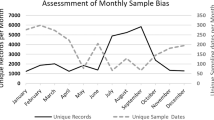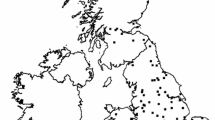Summary
Butterfly species lists were assembled for 18 Great Basin mountain ranges for which distributional data on mammals and birds have been analysed previously by other workers. The ranges represent remnant islands of the boreal habitat that once was continuous across the Great Basin but is now restricted to higher elevations as a result of climatic change at the close of the Pleistocene. The effects of biogeographic factors (area, distance, elevation) and habitat diversity on butterfly species number were examined. The Great Basin boreal butterfly faunas were found to be depauperate overall relative that of the principal mainland source, the Rocky Mountains, and were found to have fewer species than predicted by the mainland species-area data. However, only a weak area effect, and no distance effect, was detected by bivariate and multivariate analysis. Furthermore, the habitat diversity score found to explain virtually all the variation in bird species number in the same ranges in previous studies is only marginally significantly correlated with butterflies. When the butterflies are subdivided according to their vagility, the relative differences in the species-area correlation and slope (z-value) between the vagility categories were consistent with those found previously for mammals and birds, and, as predicted by theory, less vagile taxa exhibit higher species-area correlations and z-values. Overall, differences in the insular biogeography of buttterflies and vertebrates seem to reflect fundamental ecological differences between the taxa.
Similar content being viewed by others
References
Abbott I, Grant PR (1976) Nonequilibrial bird faunas on islands. Amer Nat 110:507–528
Andrewartha HG, Birch LC (1984) The ecological web. Chicago, Univ of Chicago Press
Arnold RA (1983) Ecological studies of six endangered butterflies (Lepidoptera, Lycaenidae): island biogeography, patch dynamics, and the design of habitat preserves. Univ of California Publications in Entomology Vol. 99
Austin GT, Murphy DD (1985) Zoogeography of Great Basin butterflies: patterns of distribution and speciation. Great Basin Nat Mem
Billings WD (1978) Alpine phytogeography across the Great Basin. Great Basin Nat Mem 2:105–118
Brown JH (1971) Mammals on mountaintops: nonequilibrium insular biogeography. Amer Nat 105:467–478
Brown JH (1978) The theory of insular biogeography and the distribution of boreal birds and mammals. Great Basin Nat Mem 2:209–227
Brown IL, Ehrlich PR (1980) Population biology of the checkerspot butterfly, Euphydryas chalcedona. Structure of the Jasper Ridge colony. Oecologia (Berlin) 47:239–251
Case TJ (1975) Species number, density compensation, and colonizing ability of lizards on islands in the Gulf of California. Ecology 56:3–18
Connor EF, McCoy ED (1979) The statistics and biology of the species-area relationship. Amer Nat 113:791–833
Cronquist A, Holmgren AH, Holmgren NH, Reveal JL (1972) Intermountain Flora, Vol I. New York, Hafner Publishing Co
Dempster JP (1983) The natural control of populations of butterflies and moths. Biol Rev 58:461–481
Diamond JM (1972) Biogeographic kinetics: estimation of relaxation times for avifaunas of southwest Pacific islands. Proc Nat Acad Sci USA 69:3199–3203
Diamond JM (1984) “Normal” extinctions of isolated populations. In Extinctions. Nitecki MH (ed) pp 191–246
Diamond JM, Mayr E (1976) Species-area relation for birds of the Solomon Archipelago. Proc Nat Acad Sci USA 73:262–266
Diamond JM, Gilpin ME (1980) Turnover noise: contribution to variance in species number and prediction from immigration and extinction curves. Amer Nat 115:884–889
Diamond JM, May RM (1977) Species turnover rates on islands: depenence on census interval. Science 197:266–270
Diamond JM, May RM (1981) Island biogeography and the design of nature reserves. In Theoretical ecology. May RH (ed) pp 228–252
Ehrlich PR (1965) The population biology of the butterfly Euphydryas editha. III The structure of the Jasper Ridge colony. Evolution 19:327–336
Ehrlich PR (1983) Genetics and the extinction of butterfly populations. In Genetics and conservation: a reference for managing wild animal and plant populations. Schonewald-Cox CM (eds) pp 152–163
Ehrlich PR, Murphy DD, Singer MC, Sherwood CB, White RR, Brown IL (1980) Extinction, reduction, stability and increase: the responses of checkerspot butterfly (Euphydryas) populations to the drought. Oecologia (Berlin) 46:101–105
Gilbert LE, Singer MC (1973) Dispersal and gene flow in a butterfly species. Amer Nat 107:58–73
Gilpin ME, Diamond JM (1976) Calculation of immigration and extinction curves from the species-area-distance relation. Proc Nat Acad Sci USA 73:4130–4134
Gould SJ (1979) An allometric interpretation of species-area curves: the meaning of the coefficient. Amer Naturalist 114:335–343
Harper KT, Reveal JL (1978) Intermountain biogeography: a symposium. Great Basin Nat Mem No. 2 p 268
Hamilton TH, Rubinoff I, Barth CH, Bush GL (1963) Species abundance: natural regulation of insular variation. Science 142:1575–1577
Heaney LR (1983) Mammalian species richness on islands on the Sunda Shelf, Southeast Asia. Oecologia (Berlin) 61:11–17
Holdren CE, Ehrlich PR (1981) Long range dispersal in checkerspot butterflies: transplant experiments with Euphydryas gillettii. Oecologia (Berlin) 50:125–129
Johnson MP, Raven PH (1973) Species number and endemism: the Galapagos Archipelago revisited. Science 179:893–895
Johnson NK (1975) Controls of the number of bird species on montane islands in the Great Basin. Evolution 29:545–567
MacArthur RH (1972) Geographical ecology. New York, Harper and Row
MacArthur RH, Wilson EO (1963) An equilibrium theory of insular zoography. Evolution 17:373–387
MacArthur RH, Wilson EO (1967) The theory of island biogeography. Princeton, Prineton University Press
Martin TE (1981) Species-area slopes and coefficients: a caution on their interpretation. Amer Nat 118:823–837
Murphy DD, Wilcox BA (1986) butterfly diversity in natural forest fragments: a test of the validity of vertebrate-based management. In: Verner J, Morrison ML, Ralph CJ (eds) Modeling habitat relationships of terrestrial vertebrates (in press)
Murphy DD, Wilcox BA, Austin GT, Ehrlich PR (1985) Butterflies of the Great Basin ranges. J Res Lepid (in press)
Opler PA (1974) Oaks as evolutionary islands for leaf-mining insects. Amer Scientist 62:67–73
Orsak L (1976) Management recommendations for populations of the Bright Blue Copper butterfly (Lycaena heteronea clara) of Southern California. Atala 4:10–18
Preston FW (1962) The canonical distribution of commonness and rarity. Ecology 43:185–215, 410–432
Power DM (1972) Numbers of bird species on the California Islands. Evolution 26:451–463
Schoener TW (1976) The species-area relation within archipelagoes: models and evidence from land birds. In Proceedings of the 16th International Ornithological Congress. Firth HJ, Calaby JH (eds) pp629–642
Schoener TW (1983) Rate of species turnover decreases from lower to higher organisms: a review of the data. Oikos 41:372–377
Scott JA (1972) Biogeography of Antillean butterflies. Biotropica 4:32–45
Sharp MA, Parks DR (1973) Habitat selection and populations structure in Plebejus saepiolis boiduval (Lycacnidae). J Lepid Soc 27:17–22
Shreeve TG, Mason CF (1980) The number of butterfly species in woodlands. Oecologia (Berlin) 45:414–418
Simberloff DS (1976) Species turnover and equilibrium island biogeography. Science 194:572–578
Sugihara G (1981) S=CAz, z=1/4: a reply to Conner and McCoy. Amer Nat 117:790–793
Terborgh J (1974) Presevation of natural diversity: the problem of extinction prone species. Bio Science 24:715–722
Terborgh J (1975) Faunal equilibria and the design of wildlife preserves. In: Tropical ecological systems, trends in terrestrial and aquatic research. Golly FB, Medina E (eds)
Vuilleumier F (1970) Insular biogeography of inuslar continental regions. I. The northern Andes of South America. Amer Nat 104:373–388
Weissman DB, Rentz DE (1976) Zoogeography of the grasshoppers and their relatives (Orthoptera) on the California Islands. J Biogeography 3:105–114
Wells PV (1983) Paleobiogeography of montane islands in the Great Basin since the last glaciopluvial. Ecol Monogr 53:341–382
Wilcox BA (1978) Supersaturated island faunas: a species-age relationship for lizards on post-Pleistocene landbridge islands. Science 199:996–998
Wilcox BA (1979) Species number, stability, and equilibrium status. In The California islands: proceedings of a multidisciplinary symposium. Power MD (ed), pp 551–564
Wilcox BA (1980a) Insular ecology and conservation. In Conservation biology: an evolutionary-ecological perspective. Soule ME, Wilcox BA (eds), pp 95–118
Wilcox BA (1980b) Aspects of the biogeography and evolutionary ecology of some island vertebrates. Ph.D. dissertation, Univ of California, San Diego
Wilcox BA, Murphy DD (1985) Conservation strategy: the effects of fragmentation on extinction. Amer Nat 125:879–887
Williams CB (1964) Patterns in the balance of nature and related problems in quantitative ecology. New York, Academic Press
Wright SJ (1981) Intra-archipelago vertebrate distributions: the slope of the species-area relation. Amer Nat 118:726–748
Author information
Authors and Affiliations
Rights and permissions
About this article
Cite this article
Wilcox, B.A., Murphy, D.D., Ehrlich, P.R. et al. Insular biogeography of the montane butterfly faunas in the Great Basin: comparison with birds and mammals. Oecologia 69, 188–194 (1986). https://doi.org/10.1007/BF00377620
Received:
Issue Date:
DOI: https://doi.org/10.1007/BF00377620




